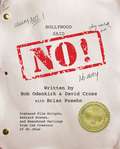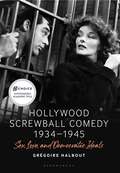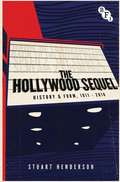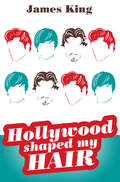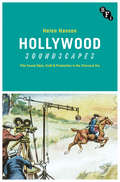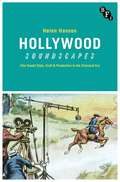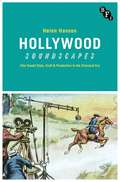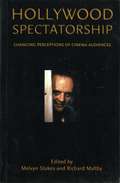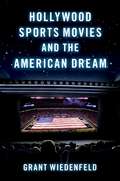- Table View
- List View
The Hollywood Romantic Comedy: Conventions, History, Controversies
by Leger GrindonThe most up-to-date study of the Hollywood romantic comedy film, from the development of sound to the twenty-first century, this book examines the history and conventions of the genre and surveys the controversies arising from the critical responses to these films. Provides a detailed interpretation of important romantic comedy films from as early as 1932 to movies made in the twenty-first century Presents a full analysis of the range of romantic comedy conventions, including dramatic conflicts, characters, plots, settings, and the function of humor Develops a survey of romantic comedy movies and builds a canon of key films from Hollywood's classical era right up to the present day Chapters work as discrete studies as well as within the larger context of the book
The Hollywood Romantic Comedy: Conventions, History, Controversies (New Approaches To Film Genre Ser.)
by Leger GrindonThe most up-to-date study of the Hollywood romantic comedy film, from the development of sound to the twenty-first century, this book examines the history and conventions of the genre and surveys the controversies arising from the critical responses to these films. Provides a detailed interpretation of important romantic comedy films from as early as 1932 to movies made in the twenty-first century Presents a full analysis of the range of romantic comedy conventions, including dramatic conflicts, characters, plots, settings, and the function of humor Develops a survey of romantic comedy movies and builds a canon of key films from Hollywood's classical era right up to the present day Chapters work as discrete studies as well as within the larger context of the book
Hollywood Said No!: Orphaned Film Scripts, Bastard Scenes, and Abandoned Darlings from the Creators of Mr. Show
by David Cross Bob OdenkirkBob Odenkirk and David Cross, creators of HBO's classic sketch comedy show Mr. Show, present to you this collection of never-before-seen scripts and ideas that Hollywood couldn't find the gumption to green-light. Simply put...HOLLYWOOD SAID NO!Since Mr. Show closed up shop, Bob and David have kept busy with many projects--acting in fun, successful, movies and TV shows, directing things, and complaining about stuff that didn't turn out well to anyone who would listen, and even alone, in silence, inside their own heads.HOLLYWOOD SAID NO! reveals the full-length, never-before-seen scripts for Bob and David Make a Movie (fleshed out with brand-new storyboards by acclaimed artist Mike Mitchell) and Hooray For America!: a satirical power-house indictment of all that you hold dear. This tome also includes a bonus section of orphaned sketch ideas from the Mr. Show days and beyond, suitable for performance by church groups that aren't all koo-koo about religion. What you are looking at online, and are about to buy, is chock-full of comic twists, turns, and maybe a few hard truths. We said "maybe," but what we mean was "probably not."Now, for the first time, take a peek at the scripts that didn't get the go-ahead and ponder a world we can only dream about...and beyond!
Hollywood Screwball Comedy 1934-1945: Sex, Love, and Democratic Ideals
by Grégoire HalboutLove at first sight, whirlwind marriages, break-ups, divorces, remarriage… What accounts for the enduring success of the Hollywood madcap comedies of the 1930s? Directed by masters of comedy (Hawks, LaCava, Leisen, Ruggles...) and featuring the decade's most iconic stars (Colbert, Dunne, Grant, Hepburn...), these films set romantic comedy standards for decades to come. Screwball comedy embarked on two challenging missions: to poke fun at established social norms and to undermine stereotypical depictions of gender roles, putting forward a discourse that postulated the possibility of equality between men and women. Grégoire Halbout's reexamination of screwball comedy provides a comprehensive overview of this (sub)genre, eschewing the auteurist approach and including “minor” works never before analyzed through the screwball lens. His book explains how these screwball stories met the expectations of a booming American middle class eager for the liberalization of morals, with daring plots, verbal humor and slapstick techniques. Building on the work of Cavell, Altman and Gehring, as well as international and French scholarship, Halbout's investigation unfolds in three parts. He first establishes a definition of Hollywood screwball comedy through a cross-sectional analysis of its socio-historical context and an in-depth examination of the genre. He then situates screwball comedy in relation to its institutional context. An exclusive study of archival material explains the emergence of a screwball aesthetic meant to subvert the prohibitions of the 1934 Hollywood Production Code through a verbal and visual rhetoric of diversion and mitigation. Finally, Halbout explores the social function of the genre's placement of romantic intimacy at the center of the public sphere and the democratic debate, confirming that screwball eccentricity upholds America's founding values: freedom of speech, free consent, and contractual engagement.
Hollywood Screwball Comedy 1934-1945: Sex, Love, and Democratic Ideals
by Grégoire HalboutLove at first sight, whirlwind marriages, break-ups, divorces, remarriage… What accounts for the enduring success of the Hollywood madcap comedies of the 1930s? Directed by masters of comedy (Hawks, LaCava, Leisen, Ruggles...) and featuring the decade's most iconic stars (Colbert, Dunne, Grant, Hepburn...), these films set romantic comedy standards for decades to come. Screwball comedy embarked on two challenging missions: to poke fun at established social norms and to undermine stereotypical depictions of gender roles, putting forward a discourse that postulated the possibility of equality between men and women. Grégoire Halbout's reexamination of screwball comedy provides a comprehensive overview of this (sub)genre, eschewing the auteurist approach and including “minor” works never before analyzed through the screwball lens. His book explains how these screwball stories met the expectations of a booming American middle class eager for the liberalization of morals, with daring plots, verbal humor and slapstick techniques. Building on the work of Cavell, Altman and Gehring, as well as international and French scholarship, Halbout's investigation unfolds in three parts. He first establishes a definition of Hollywood screwball comedy through a cross-sectional analysis of its socio-historical context and an in-depth examination of the genre. He then situates screwball comedy in relation to its institutional context. An exclusive study of archival material explains the emergence of a screwball aesthetic meant to subvert the prohibitions of the 1934 Hollywood Production Code through a verbal and visual rhetoric of diversion and mitigation. Finally, Halbout explores the social function of the genre's placement of romantic intimacy at the center of the public sphere and the democratic debate, confirming that screwball eccentricity upholds America's founding values: freedom of speech, free consent, and contractual engagement.
The Hollywood Sequel: History & Form, 1911-2010
by Stuart HendersonThis illuminating study charts the changing role of the Hollywood film sequel over the past century. Considering a range of sequels in their industrial, historical and aesthetic contexts, from The Son of a Sheik (1926) to Toy Story 3 (2010), this book provides a comprehensive history of this critically-neglected yet commercially-dominant art form.
HOLLYWOOD SHAPED MY HAIR
by James KingA humorous look at the influence of celebrity style, charting the hairdos (and hair don’ts) James King has fashioned over the years.
Hollywood Shot by Shot: Alcoholism in American Cinema
by Norman K. DenzinTo what extent have Hollywood feature films shaped the meanings that Americans attach to alcoholics, their families, and the alcoholic condition? To what extent has the mass culture of the movie industry itself been conceptually shaped by a broad, external societal discourse? Norman Denzin brings to his life-long study of alcoholism a searching interest in how cultural texts signify and lend themselves to interpretation within a social nexus. Both historical and diachronic in his approach, Denzin identifies five periods in the alcoholism films made between 1932 and the end of the 1980s, and offers a detailed critical reading of thirty-seven films produced during these six decades.
Hollywood Shot by Shot: Alcoholism in American Cinema (Communication And Social Order Ser.)
by Norman K. DenzinTo what extent have Hollywood feature films shaped the meanings that Americans attach to alcoholics, their families, and the alcoholic condition? To what extent has the mass culture of the movie industry itself been conceptually shaped by a broad, external societal discourse? Norman Denzin brings to his life-long study of alcoholism a searching interest in how cultural texts signify and lend themselves to interpretation within a social nexus. Both historical and diachronic in his approach, Denzin identifies five periods in the alcoholism films made between 1932 and the end of the 1980s, and offers a detailed critical reading of thirty-seven films produced during these six decades.
Hollywood Sound Design and Moviesound Newsletter: A Case Study of the End of the Analog Age
by David StoneAs film students and younger fans experience "Big Hollywood Sound" in Imax presentations and digital theaters, many are also discovering action and adventure movies made well before they were born. There is a legacy to be enjoyed in the sound of these films: Blockbuster movies of the ‘80’s, and ‘90’s are notable for the extraordinarily dramatic impact of their sound mixing, and the way in which it could immerse audiences in a surrounding space. During this period, a small group of sound professionals in Hollywood wrote and published a critical journal about the craftsmanship, new technology, and changing aesthetics that excited conversation in their community. Their work has been edited and compiled here for the first time. David Stone is a sound editor, a veteran of roughly 100 Hollywood feature films, such as Gremlins, Top Gun, Die Hard, Speed, and Ocean’s 11. He was a Supervising Sound Editor for projects as varied as Predator, Edward Scissorhands, Beauty and the Beast, Batman Returns, City Slickers 2, and Dolores Claiborne. He has collected Golden Reel awards for Best Sound Editing five times, and won the 1992 Academy Award® for best Sound Effects Editing, for his supervising work on Bram Stoker’s Dracula. In 2015, he received a Lifetime Achievement Award from the San Luis Obispo Jewish Film Festival in California. Stone is now a Professor and former Chair of Sound Design at Savannah College of Art and Design. Between 1989 and 1994, he was the editor of Moviesound Newsletter, which was published by Vanessa Ament. Dr. Vanessa Theme Ament is the author of The Foley Grail, and a contributor to Sound: Dialogue, Music, and Effects (the Silver Screen Series). She is on the steering committee for Cinesonika, an international film festival and conference. A veteran Foley artist, sound editor, and voice actor from Los Angeles, she also writes and sings jazz, and is a member of the American Federation of Musicians, SAG-AFTRA, Actors Equity, and the Editors Guild. She worked on Die Hard, sex, lies, and videotape, Platoon, Predator, Edward Scissorhands, Beauty and the Beast, Noises Off, and A Goofy Movie, and many other films. Dr. Ament received her Ph.D. in Communication, in the area of Moving Image Studies, from Georgia State University in Atlanta, and is presently the Edmund F. and Virginia B. Ball Endowed Chair Professor of Telecommunications, at Ball State University in Muncie, Indiana.
Hollywood Sound Design and Moviesound Newsletter: A Case Study of the End of the Analog Age
by David StoneAs film students and younger fans experience "Big Hollywood Sound" in Imax presentations and digital theaters, many are also discovering action and adventure movies made well before they were born. There is a legacy to be enjoyed in the sound of these films: Blockbuster movies of the ‘80’s, and ‘90’s are notable for the extraordinarily dramatic impact of their sound mixing, and the way in which it could immerse audiences in a surrounding space. During this period, a small group of sound professionals in Hollywood wrote and published a critical journal about the craftsmanship, new technology, and changing aesthetics that excited conversation in their community. Their work has been edited and compiled here for the first time. David Stone is a sound editor, a veteran of roughly 100 Hollywood feature films, such as Gremlins, Top Gun, Die Hard, Speed, and Ocean’s 11. He was a Supervising Sound Editor for projects as varied as Predator, Edward Scissorhands, Beauty and the Beast, Batman Returns, City Slickers 2, and Dolores Claiborne. He has collected Golden Reel awards for Best Sound Editing five times, and won the 1992 Academy Award® for best Sound Effects Editing, for his supervising work on Bram Stoker’s Dracula. In 2015, he received a Lifetime Achievement Award from the San Luis Obispo Jewish Film Festival in California. Stone is now a Professor and former Chair of Sound Design at Savannah College of Art and Design. Between 1989 and 1994, he was the editor of Moviesound Newsletter, which was published by Vanessa Ament. Dr. Vanessa Theme Ament is the author of The Foley Grail, and a contributor to Sound: Dialogue, Music, and Effects (the Silver Screen Series). She is on the steering committee for Cinesonika, an international film festival and conference. A veteran Foley artist, sound editor, and voice actor from Los Angeles, she also writes and sings jazz, and is a member of the American Federation of Musicians, SAG-AFTRA, Actors Equity, and the Editors Guild. She worked on Die Hard, sex, lies, and videotape, Platoon, Predator, Edward Scissorhands, Beauty and the Beast, Noises Off, and A Goofy Movie, and many other films. Dr. Ament received her Ph.D. in Communication, in the area of Moving Image Studies, from Georgia State University in Atlanta, and is presently the Edmund F. and Virginia B. Ball Endowed Chair Professor of Telecommunications, at Ball State University in Muncie, Indiana.
Hollywood Soundscapes: Film Sound Style, Craft and Production in the Classical Era
by Helen HansonThe technical crafts of sound in classical Hollywood cinema have, until recently, remained largely ‘unsung’ by histories of the studio era. Yet film sound – voice, music and sound effects – is a crucial aspect of film style and has been key to engaging and holding audiences since the transition to sound by Hollywood’s major studios in 1929. This innovative new text restores sound technicians to Hollywood’s creative history. Exploring a range of films from the early sound period (1931) through to the late studio period (1948), and drawing on a wide range of archival sources, the book reveals how Hollywood’s sound designers worked and why they worked in the ways that they did. The book demonstrates how sound technicians developed conventions designed to tell stories through sound, placing them within the production cultures of studio era filmmaking, and uncovering a history of collective and collaborative creativity. In doing so, it traces the emergence of a body of highly skilled sound personnel, able to apply expert technical knowledge in the science of sound to the creation of cinematic soundscapes that are alive with mood and sensation.
Hollywood Soundscapes: Film Sound Style, Craft and Production in the Classical Era
by Helen HansonThe technical crafts of sound in classical Hollywood cinema have, until recently, remained largely ‘unsung’ by histories of the studio era. Yet film sound – voice, music and sound effects – is a crucial aspect of film style and has been key to engaging and holding audiences since the transition to sound by Hollywood’s major studios in 1929. This innovative new text restores sound technicians to Hollywood’s creative history. Exploring a range of films from the early sound period (1931) through to the late studio period (1948), and drawing on a wide range of archival sources, the book reveals how Hollywood’s sound designers worked and why they worked in the ways that they did. The book demonstrates how sound technicians developed conventions designed to tell stories through sound, placing them within the production cultures of studio era filmmaking, and uncovering a history of collective and collaborative creativity. In doing so, it traces the emergence of a body of highly skilled sound personnel, able to apply expert technical knowledge in the science of sound to the creation of cinematic soundscapes that are alive with mood and sensation.
Hollywood Soundscapes: Film Sound Style, Craft and Production in the Classical Era
by Helen HansonThe technical crafts of sound in classical Hollywood cinema have, until recently, remained largely 'unsung' by histories of the studio era. Yet film sound – voice, music and sound effects – is a crucial aspect of film style and has been key to engaging and holding audiences since the transition to sound by Hollywood's major studios in 1929. This innovative new text restores sound technicians to Hollywood's creative history. Exploring a range of films from the early sound period (1931) through to the late studio period (1948), and drawing on a wide range of archival sources, the book reveals how Hollywood's sound designers worked and why they worked in the ways that they did. The book demonstrates how sound technicians developed conventions designed to tell stories through sound, placing them within the production cultures of studio era filmmaking, and uncovering a history of collective and collaborative creativity. In doing so, it traces the emergence of a body of highly skilled sound personnel, able to apply expert technical knowledge in the science of sound to the creation of cinematic soundscapes that are alive with mood and sensation.
Hollywood Soundscapes: Film Sound Style, Craft and Production in the Classical Era
by Helen HansonThe technical crafts of sound in classical Hollywood cinema have, until recently, remained largely 'unsung' by histories of the studio era. Yet film sound – voice, music and sound effects – is a crucial aspect of film style and has been key to engaging and holding audiences since the transition to sound by Hollywood's major studios in 1929. This innovative new text restores sound technicians to Hollywood's creative history. Exploring a range of films from the early sound period (1931) through to the late studio period (1948), and drawing on a wide range of archival sources, the book reveals how Hollywood's sound designers worked and why they worked in the ways that they did. The book demonstrates how sound technicians developed conventions designed to tell stories through sound, placing them within the production cultures of studio era filmmaking, and uncovering a history of collective and collaborative creativity. In doing so, it traces the emergence of a body of highly skilled sound personnel, able to apply expert technical knowledge in the science of sound to the creation of cinematic soundscapes that are alive with mood and sensation.
Hollywood Speaks Out: Pictures that Dared to Protest Real World Issues
by Robert L. HilliardHollywood Speaks Out explores that rare Hollywood feature that dared to tackle red-hot, social issues whilst American society was gripped by the convulsion and controversy they generated. Explores why Hollywood has always been risk-adverse, and how most feature flms deal with controversial issues long after the controversy is past Organized around such important issues as poverty, racism, sexism, war, anti-Semitism, and homophobia Discusses the relevance and the impact of feature films from Modern Times to WALL-E
Hollywood Spectatorship: Changing Perceptions of Cinema Audiences
by Melvyn Stokes Richard MaltbyThis is an examination of the concepts of spectatorship in the light of historical accounts of audience reception. The book looks at how audiences have historically talked about Hollywood movies, and the ways in which 'word-of-mouth' responses have affected the reception of individual movies.
Hollywood Spectatorship: Changing Perceptions of Cinema Audiences
This is an examination of the concepts of spectatorship in the light of historical accounts of audience reception. The book looks at how audiences have historically talked about Hollywood movies, and the ways in which 'word-of-mouth' responses have affected the reception of individual movies.
Hollywood Sports Movies and the American Dream
by Grant WiedenfeldThrough the heart of Hollywood cinema runs an unexpected current of progressive politics. Sports movies, a genre that has flourished since the mid-seventies, evoke the American dream and therefore represent the nation to itself in idealized form. Once considered mere credos for Reaganism's fantasies of an atomized society, movies from Rocky (1976) to Ali (2001) dream of democratic participation and recognition more than individual success, for in every case, off-field relationships take precedence over on-field competition. Arranged chronologically, Hollywood Sports Films and the American Dream is a critical study of six major sports films that re-tells the story of multiculturalism's gradual adoption in the latter third of the 20th century and rewrites contemporary understandings of the sports film. For author Grant Wiedenfeld, the mainstream's first minority heroes are paradoxically white ethnic, rural, working-class men, exemplified by Rocky, Slap Shot (1977) and The Natural (1984) and Black, brown, and women characters follow in White Men Can't Jump (1992), A League of Their Own (1992), and Ali. But despite their insistence on community and diversity these popular dramas show limited faith in civic institutions and point to the limits of inclusion and participation in the post-Civil Rights era. Hannah Arendt, Jeffrey Alexander, and others inform Wiedenfeld's original analysis and commentary on the political significance of popular culture as he insists on the cinema's capabilities as an engine for democracy untethered from more conventional 'democratic' institutions. Reading these familiar movies from another angle paints a fresh picture of how the United States has imagined democracy since its bicentennial and renews the political efficacy of one of the most popular genres in film history.
Hollywood Sports Movies and the American Dream
by Grant WiedenfeldThrough the heart of Hollywood cinema runs an unexpected current of progressive politics. Sports movies, a genre that has flourished since the mid-seventies, evoke the American dream and therefore represent the nation to itself in idealized form. Once considered mere credos for Reaganism's fantasies of an atomized society, movies from Rocky (1976) to Ali (2001) dream of democratic participation and recognition more than individual success, for in every case, off-field relationships take precedence over on-field competition. Arranged chronologically, Hollywood Sports Films and the American Dream is a critical study of six major sports films that re-tells the story of multiculturalism's gradual adoption in the latter third of the 20th century and rewrites contemporary understandings of the sports film. For author Grant Wiedenfeld, the mainstream's first minority heroes are paradoxically white ethnic, rural, working-class men, exemplified by Rocky, Slap Shot (1977) and The Natural (1984) and Black, brown, and women characters follow in White Men Can't Jump (1992), A League of Their Own (1992), and Ali. But despite their insistence on community and diversity these popular dramas show limited faith in civic institutions and point to the limits of inclusion and participation in the post-Civil Rights era. Hannah Arendt, Jeffrey Alexander, and others inform Wiedenfeld's original analysis and commentary on the political significance of popular culture as he insists on the cinema's capabilities as an engine for democracy untethered from more conventional 'democratic' institutions. Reading these familiar movies from another angle paints a fresh picture of how the United States has imagined democracy since its bicentennial and renews the political efficacy of one of the most popular genres in film history.
Hollywood Stardom
by Paul McDonaldBy integrating star studies and film industry studies, Hollywood Stardom reveals the inextricable bonds between culture and commerce in contemporary notions of film stardom. Integrates the traditions of star studies and industry studies to establish an original and innovative mode of analysis whereby the ‘star image’ is replaced with the ‘star brand’ Offers the first extensive analysis of stardom in the ‘post-studio’ era Combines genre, narrative, acting, and discourse analysis with aspects of marketing theory and the economic analysis of the film market Draws on an extensive body of research data not previously deployed in film scholarship A wide range of star examples are explored including George Clooney, Mel Gibson, Tom Cruise, Daniel Day-Lewis, Tom Hanks, Will Smith, and Julia Roberts
Hollywood Stardom
by Paul McDonaldBy integrating star studies and film industry studies, Hollywood Stardom reveals the inextricable bonds between culture and commerce in contemporary notions of film stardom. Integrates the traditions of star studies and industry studies to establish an original and innovative mode of analysis whereby the ‘star image’ is replaced with the ‘star brand’ Offers the first extensive analysis of stardom in the ‘post-studio’ era Combines genre, narrative, acting, and discourse analysis with aspects of marketing theory and the economic analysis of the film market Draws on an extensive body of research data not previously deployed in film scholarship A wide range of star examples are explored including George Clooney, Mel Gibson, Tom Cruise, Daniel Day-Lewis, Tom Hanks, Will Smith, and Julia Roberts
The Hollywood Studio System: A History
by Douglas GomeryDespite being one of the biggest industries in the United States, indeed the World, the internal workings of the 'dream factory' that is Hollywood is little understood outside the business. The Hollywood Studio System: A History is the first book to describe and analyse the complete development, classic operation, and reinvention of the global corporate entitles which produce and distribute most of the films we watch. Starting in 1920, Adolph Zukor, Head of Paramount Pictures, over the decade of the 1920s helped to fashion Hollywood into a vertically integrated system, a set of economic innovations which was firmly in place by 1930. For the next three decades, the movie industry in the United States and the rest of the world operated by according to these principles. Cultural, social and economic changes ensured the dernise of this system after the Second World War. A new way to run Hollywood was required. Beginning in 1962, Lew Wasserman of Universal Studios emerged as the key innovator in creating a second studio system. He realized that creating a global media conglomerate was more important than simply being vertically integrated. Gomery's history tells the story of a 'tale of two systems 'using primary materials from a score of archives across the United States as well as a close reading of both the business and trade press of the time. Together with a range of photographs never before published the book also features over 150 box features illuminating aspect of the business.
The Hollywood Studio System: A History
by NA NADespite being one of the biggest industries in the United States, indeed the World, the internal workings of the 'dream factory' that is Hollywood is little understood outside the business. The Hollywood Studio System: A History is the first book to describe and analyse the complete development, classic operation, and reinvention of the global corporate entitles which produce and distribute most of the films we watch. Starting in 1920, Adolph Zukor, Head of Paramount Pictures, over the decade of the 1920s helped to fashion Hollywood into a vertically integrated system, a set of economic innovations which was firmly in place by 1930. For the next three decades, the movie industry in the United States and the rest of the world operated by according to these principles. Cultural, social and economic changes ensured the dernise of this system after the Second World War. A new way to run Hollywood was required. Beginning in 1962, Lew Wasserman of Universal Studios emerged as the key innovator in creating a second studio system. He realized that creating a global media conglomerate was more important than simply being vertically integrated. Gomery's history tells the story of a 'tale of two systems 'using primary materials from a score of archives across the United States as well as a close reading of both the business and trade press of the time. Together with a range of photographs never before published the book also features over 150 box features illuminating aspect of the business.
Hollywood Vampire: The Apocalypse - An Unofficial and Unauthorised Guide to the Final Season of Angel
by Keith ToppingLeaving behind his life in Sunnydale and his relationship with Buffy Sunners, Angel atones for his sins by fighting for humanity in the dark seedy underworld of the superficially glamorous city of L.A. Angel Investigations has moved from the Hyperion Hotel to running Wolfram & Hart, but has their conviction to be champions survived the upheaval?In his comprehensive unofficial guide to Season Five of Angel's world, Keith Topping, bestselling author of Slayer, the unofficial guide to Buffy, looks at each episode in turn, considering the links and cross-references between Angel and Buffy, draws attention to logic flaws, points out numerous pop-culture references and discusses recurrent themes and coverage of Angel on the Internet.This essential guide to the final season of the popular show explores the world of Angel, Wesley, Gunn, Fred, Lorne and Spike as they fight their own personal demons and the loneliness of the Big City in their search for redemption.

